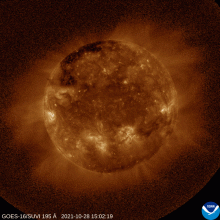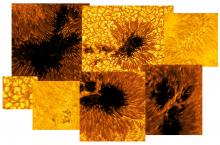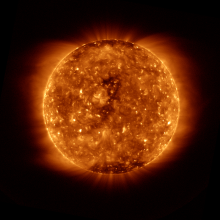Listen to today's episode of StarDate on the web the same day it airs in high-quality streaming audio without any extra ads or announcements. Choose a $8 one-month pass, or listen every day for a year for just $30.
You are here
Matching Storms
An unsettled Sun may have a big impact on some of the biggest weather-makers on Earth: El Niño and La Niña. These alternating events in the Pacific Ocean can bring floods to some parts of the world and droughts to others, and alter global temperatures for months or years. And a recent study found a strong correlation between the cycles of El Niño and La Niña and the magnetic cycle of the Sun.
The solar cycle lasts about 11 years. At its peak, it produces many sunspots — dark magnetic storms on the surface of the Sun — as well as big outbursts of radiation and particles. And at the cycle’s low point, the Sun is quiet, with few if any magnetic storms.
Researchers looked at records of solar activity from 1900 to 2018. They compared that to records of El Niño and La Niña over the same period. And they found a match. When solar activity was high, the temperature of the North Pacific was high as well. That correlated to longer and stronger bouts of El Niño. And when the Sun was quiet, Pacific temperatures were lower and La Niña was more likely to appear.
The extra energy during the Sun’s high point may first warm a layer of Earth’s upper atmosphere. That warms the air below, changing a large circulation pattern. And that warms the North Pacific, which in turn warms the Central Pacific — the birthplace of many El Niño and La Niña events. So to get a general idea of what to expect here on Earth, we may want to look to the Sun.
Script by Damond Benningfield





